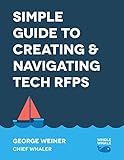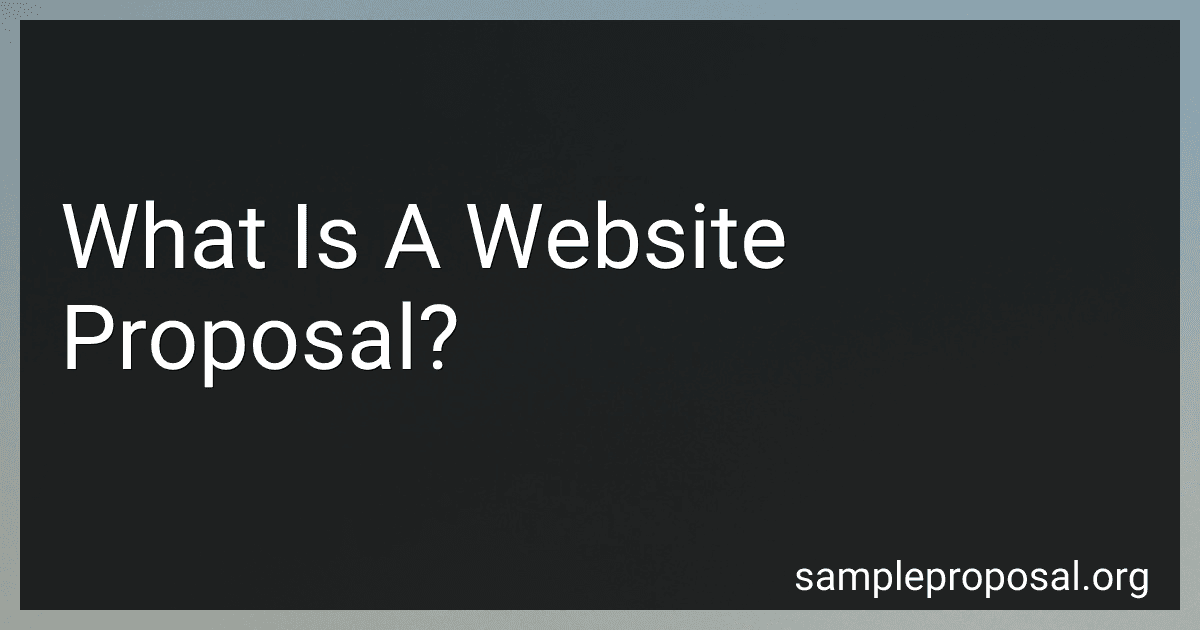Best Website Proposal Guides to Buy in December 2025

Grant Writing Book for Business & Nonprofit Fundraising: Learn How to Write Winning Proposals with Step by Step Example Templates for Novice Beginners



Simple Guide to Creating & Navigating Tech RFPs: RFP Examples, Templates, Checklists



A Modest Proposal


A website proposal is a comprehensive document that outlines the strategy, scope, and execution plan for developing a website. It is typically used by web development agencies or freelancers to present their vision and plan to potential clients, serving as both a marketing tool and a project blueprint. The proposal includes a detailed description of the website's purpose, target audience, design concepts, technological specifications, functionalities, and a timeline for completion. It also covers the costs involved, including pricing for design, development, and any ongoing maintenance or updates. The proposal aims to align the expectations of the client and the service provider, ensuring mutual understanding of the project's goals and deliverables. Additionally, it often highlights the credentials and experience of the team, showcasing previous work and demonstrating their capability to execute the project successfully.
What is the purpose of a website proposal?
A website proposal serves several important purposes:
- Clear Communication: It outlines the understanding between the web developer (or development agency) and the client regarding what the project entails. This includes goals, scope, features, and deliverables.
- Project Scope: It helps define the scope of the project by detailing the specific tasks, functionalities, and specifications. This reduces misunderstandings and scope creep later in the project.
- Budgeting: The proposal includes cost estimates, helping clients understand the financial requirements and allocate their budget accordingly.
- Timeline and Milestones: It provides a timeline with milestones for the completion of various phases of the project, giving both parties a roadmap to follow.
- Professionalism: A well-crafted proposal demonstrates the professionalism and expertise of the web developer or agency, potentially increasing the likelihood of securing the project.
- Legal Framework: It can serve as a legal document that, once agreed upon and signed, binds both parties to the specified terms and conditions.
- Alignment of Expectations: By clearly laying out what is expected from both sides, it ensures that the client and the developer are on the same page, reducing the risk of disputes.
Overall, a website proposal is a critical tool in ensuring a successful web development project by providing a clear, detailed plan that aligns the expectations and responsibilities of all parties involved.
How to use visuals in a website proposal?
Using visuals in a website proposal can enhance understanding, engage stakeholders, and effectively communicate your ideas. Here’s how you can incorporate visuals effectively:
- Cover Page Design: Use an attractive cover with your company logo and the client's logo. Include a relevant image that represents the project scope or industry.
- Project Overview: Use an infographic to summarize the project scope, objectives, and key deliverables. Utilize icons to represent different sections and make them visually appealing.
- Wireframes and Mockups: Include wireframes to show layout ideas and basic structure. Provide high-fidelity mockups to illustrate design concepts more clearly.
- Process Diagrams: Use flowcharts to explain the project development process and timelines. Visualize user journeys or workflows to illustrate the user experience.
- Charts and Graphs: Present data and statistics using bar graphs, pie charts, or line graphs for clarity. Use visuals to compare current website performance with proposed improvements.
- Design Inspiration: Add mood boards or examples of design inspiration that align with the proposed style. Use screenshots of competitor websites to highlight market trends or gaps.
- Sitemaps: Include a visual sitemap to depict the website’s overall structure and navigation paths. Ensure it is clear and easy to understand for stakeholders with varying levels of technical knowledge.
- Typography and Color Schemes: Present proposed typography and color palettes as swatches. Provide examples of text hierarchy and color usage in design mockups.
- Final Deliverables: Use visuals to list deliverables clearly, possibly with icons for each deliverable. Add a timeline with visual representations of milestones and deadline icons.
- Testimonials and Case Studies: Use images with quotes from previous satisfied clients. Provide before-and-after visuals for case studies that show your capabilities.
- Call-to-Action: Design visually distinct calls-to-action throughout the proposal to guide the reader to next steps.
- Tool Tips: Incorporate annotations or footnotes as tool tips in complex visuals to provide additional context without cluttering.
By integrating these visual elements into your website proposal, you enhance clarity, make information more digestible, and create a compelling proposal that captures the interest of your target audience.
How to structure a website proposal?
Creating a well-structured website proposal is crucial for clearly communicating your understanding of the client’s needs and how you plan to meet them. Here’s a suggested structure for an effective website proposal:
- Title Page Project Title Your Company Name Client’s Name and Contact Information Date of Proposal
- Table of Contents Easy navigation through sections of the document
- Executive Summary Brief overview of the project Highlight the key objectives and outcomes
- Introduction Introduce your company and team Brief overview of your experience and expertise Why you are the right fit for this project
- Project Goals and Objectives Detailed description of the project’s primary goals Specific objectives that will be achieved, aligned with the client’s needs
- Scope of Work Description of the deliverables Key features and functionalities of the website Overall project approach and methodology
- Project Timeline Phases of the project Deliverables within each phase Estimated dates for each phase, including milestones
- Budget and Pricing Detailed breakdown of costs Payment structure (e.g., upfront deposit, payment upon milestones) Any contingencies or optional add-ons
- Assumptions and Dependencies Key assumptions underlying the proposal analysis Dependencies that are outside your control
- Terms and Conditions Legal terms, including ownership of code/content, confidentiality, etc. Cancellation policies, warranties, and liabilities
- Your Team Brief bios of key team members Relevant experience and roles in the project
- Case Studies/Portfolio Examples of past work relevant to the client’s project Testimonials from previous clients, if available
- Next Steps Encourage the client to accept the proposal Provide contact information for any questions Call-to-action for the next meeting or action
- Appendix Any additional information, charts, or graphics that support the proposal Detailed technical specifications, if needed
Remember, the key to an effective proposal is clarity and alignment with the client’s goals. Be concise, address the client’s needs directly, and tailor the content to demonstrate how your expertise will add value to their project.
What is a case study in a website proposal?
A case study in a website proposal is a detailed examination of a specific project or example that demonstrates your ability and success in delivering similar services. It serves several purposes, including showcasing your expertise, illustrating your process, and building trust with potential clients. Here's what a typical case study in a website proposal might include:
- Introduction/Background: A brief overview of the client or project. This section sets the stage by explaining who the client is, their industry, and what their initial needs or challenges were.
- Objectives/Goals: Clearly state what the client wanted to achieve with their website. This could include goals like increasing online sales, improving user experience, enhancing brand visibility, or integrating specific functionalities.
- Approach/Solution: Describe the strategy and steps you took to address the client's needs. This may involve your design and development process, tools and technologies used, and any innovative solutions or features you implemented.
- Challenges: Discuss any challenges or obstacles that arose during the project and how you overcame them. This can demonstrate your problem-solving abilities and show your resilience in challenging situations.
- Results/Outcome: Highlight the outcomes of the project, ideally with quantitative data. Metrics like increased traffic, reduced bounce rates, improved conversion rates, or positive client testimonials can effectively showcase the success of your work.
- Visuals/Before and After: Include visuals such as screenshots, design mockups, or before-and-after comparisons to provide a clear, visual representation of the transformation.
- Client Feedback/Testimonial: If possible, include a testimonial from the client, expressing satisfaction with the services provided and the results achieved.
Incorporating a well-constructed case study into your website proposal helps potential clients see real-world evidence of your capabilities, making it easier for them to envision the potential benefits of working with you.
